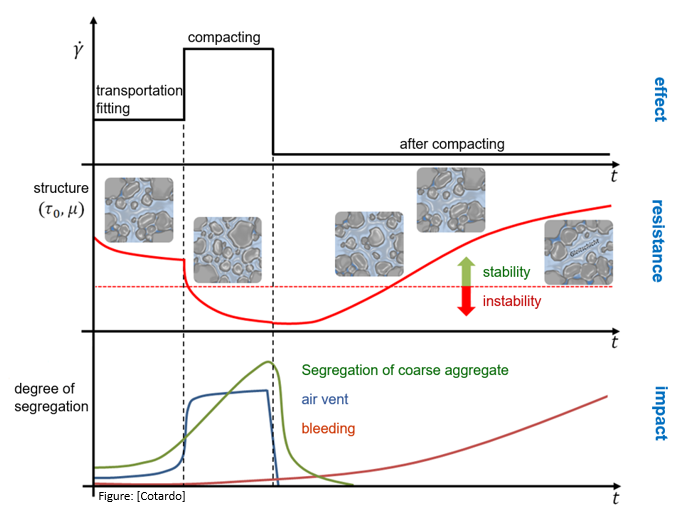8. Stability of concrete subjected to vibration – Analysis of the nano- and microscopic structural build-up and structural breakdown behavior of cementitious suspensions
Principal investigator(s) – PI
- Professor Dr.-Ing. Michael Haist
Leibniz University Hannover, Institut für Baustoffe - Professor Dr.-Ing. Ludger Lohaus
Leibniz University Hannover, Institut für Baustoffe
Researcher(s) in-charge – RI
- Dipl.-Ing. Dario Cotardo
Leibniz Universität Hannover, Institut für Baustoffe - M.Sc. Tabea von Bronk
Leibniz Universität Hannover, Institut für Baustoffe Subject Area
Associated researcher – AR
- Professor Dr. rer. nat. Nadja-C. Bigall
Leibniz Universität Hannover, Institut für Physikalische Chemie und Elektrochemie - M.Sc. Patrick André Kißling
Leibniz University Hannover, Institut für Baustoffe
Subject Areas
Construction Material Sciences, Rheology, Building Physics
Term
2018-2021
Project identifier
Deutsche Forschungsgemeinschaft (DFG) – Projekt number 411375374
Project Description
Trends in modern concrete construction are moving towards slimmer, lighter, more complex shaped and more closely reinforced components. For such structural components comparatively soft and flowable concretes are required, which have to be subjected to vibration additionally for full filling the whole formwork. But also in conventional concrete construction more flowable concretes are used to achieve more favorable processability properties of the concrete, a faster construction progress or even to an advanced mechanization and automatization of the concrete installation progress. Modern construction chemistry has contributed significantly to the further development of fresh concrete properties, in particular by providing highly effective superplasticizers. At the same time, however, this increases the complexity of the building material system. The development of self-compacting concrete (SCC) is the culmination of these trends so far. Nevertheless, the use of SCC, which must not be subjected to vibration because of the risk of segregation, is not always sufficient for very narrow reinforcement layouts and complex concreting situations. In these cases even the high flowability of SCC will not ensure a safely filling of all cavities without additional vibration energy. Generally, the risk of segregation increases with increasingly softer or more flowable consistency. Current examples of damages show that problems with the stability of concrete increase with increasing flowability and complexity of the building material system as well as under difficult and narrow concreting conditions. Although there are well-founded approaches in the field of SCC ensuring a sufficient stability of concrete, comparable approaches for soft to flowable concretes under vibration are lacking. Therefore, the segregation stability of flowable concretes being subjected to vibration is to be described based on engineering model approaches. The model approaches focus on the description of structural build-up and structural breakdown processes in the cementitious suspension. The rheological properties of the cement paste and fine grained mortar are investigated as they decisively influence the stability behavior of concrete. Additionally the influence of early hydration products on the shear- and time-dependent behavior of the suspension should be recorded. Taking into account the grading curves from coarse aggregates to very fine particles, these findings will lead to optimization strategies for increasing the segregation stability of flowable concrete under vibration.

Model presentation of the connection between structural processes and segregation phenomena due to the load history of a flowable ready-mixed concrete
Publications
in: V. Mechtcherine, K. H. Khayat, E. Secrieru (Eds.), Rheology and Processing of Construction Materials, pp. 610–618 (2019)
Materials and Structures 53 (2020)
Materials 13 (7) (2020)
